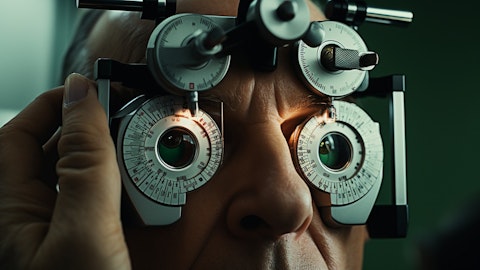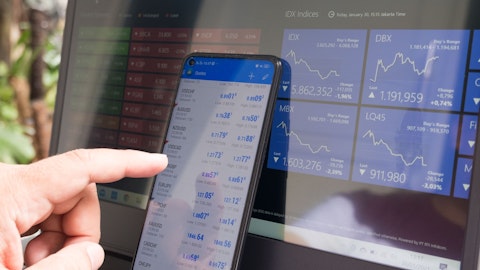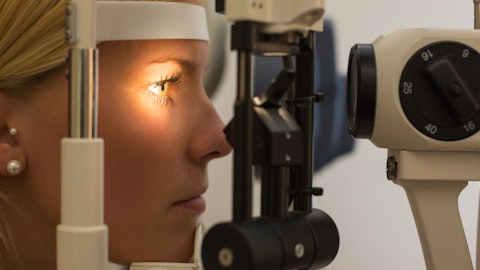Ron Kurtz: Hey, David.
Shelley Thunen: Yeah, I’m going to have Ron answer that question.
Ron Kurtz: Hey, David. So, you know, I don’t know that I would identify any specific patent as a key patent. We’ve got a very large patent portfolio that we’ve expanded over the years, as we continue to develop and further develop this technology. And so as things come off patent, there’s a whole slew of things that replaces them. Underlying your question, I think, though, is an assumption that IP is somehow critical for us, and I don’t want to minimize the importance of intellectual property. Of course, we take it very seriously and we have an excellent program to maintain and expand our portfolio. But there are a number of barriers to entry to this technology, and I wouldn’t put IP at the top of it. The number one barrier is this is just technically really hard to do.
To adjust a lens after it’s been implanted in the human body with the precision of making glasses is really difficult. And I think that it took us a long time to do it. I wish anybody luck to try to, in their quest to do it as well. And then obviously, over the last several years, we’ve built a commercial footprint, which we’re expanding, and with that comes a whole education of the field and building of expectation on the part of clinicians as to what is adjustability, what are the measures of adjustability, what are the requirements for adjustability, and we keep advancing those. And that same process, of course, is going on the regulatory front, where we continue to move the technology forward and thereby educate the regulators. And so there are just several layers of barriers.
David Saxon: Okay, perfect. Thanks for that, Ron. And then couple for probably Shelley. Gross margin was kind of flat sequentially, so can you help us with the drivers there? I think mix was better in the fourth quarter. So anything there? And then on international, have you talked about what percent of revenue is coming from international and then what pricing is in Canada, Mexico and Germany? Thanks so much.
Shelley Thunen: Okay, good. Thank you very much. Yeah, our mix between LAL and LDD in the third and the fourth quarter was very similar. And therefore, also our gross margin was similar. I think what you were perhaps intimating is that you would hope we’d have a little bit more increase in gross margin from the fact that we were selling the LDD with the higher ASP and lower costs throughout the entire fourth quarter. And I just have to say, and I think we’ve talked about this before, is that there are always period costs. And those period costs, particularly on the LAL, are things like the consumption and the ordering of glasses and cartridges and other accessories from customers, they’re not a one-for-one relationship, and we don’t charge separately for those, as well as just period costs for things like inventory reserves and on things like that, both on the LAL and LDD side.
Scrap on the LDD, it just depends quarter to quarter. So the period costs tend to have a minor impact on margin, but they can vary quarter by quarter and we saw a little of that in the fourth quarter, but that’s quite usual. And then, I think your next question was, what percent of revenue are we getting from international? And that would just be Canada in our case. And no, we don’t break it out. It has remained relatively steady in terms of their contribution on a quarterly basis but growing throughout 2023. But it’s not significant relative to the overall, but it’s a great market for us. And then, I think your third question was pricing in Canada. And we do use the distributors that changes our ASP internally a little bit. But again, it’s not predominant in terms of our overall LDD volume and LAL volume, but the absolute pricing to the end user customer in Canada is a bit higher than it is in the US.
One, they’re in an earlier stage of adoption, but more often they do expect to pay more, just because of product introductions, lower volume, things like that.
David Saxon: Okay, great. Thank you so much.
Shelley Thunen: Thank you.
Operator: All right. Thank you. This concludes the question-and-answer session. I would now like to turn it to Ron Kurtz, CEO for closing remarks.
Ron Kurtz: Thank you for your time and attention today. We appreciate your interest in RxSight and look forward to updating you on our progress in future quarters. Goodbye.
Operator: All right. Thank you for your participation in today’s conference. This does conclude the program. You may now disconnect.
Follow Rxsight Inc. (NASDAQ:RXST)
Follow Rxsight Inc. (NASDAQ:RXST)
Receive real-time insider trading and news alerts




